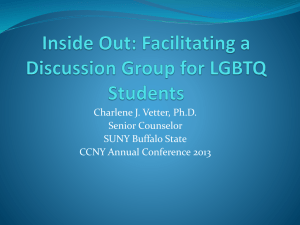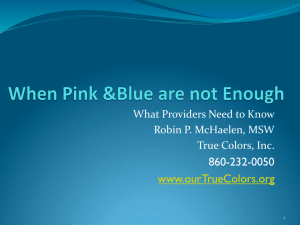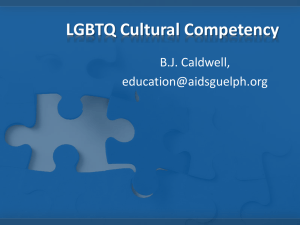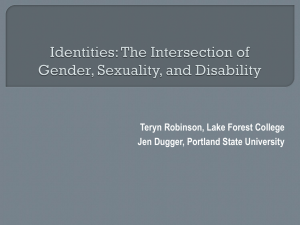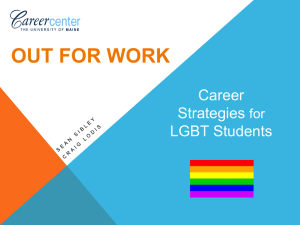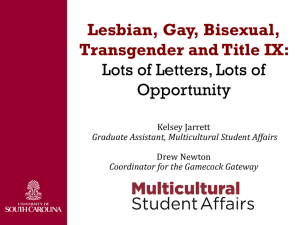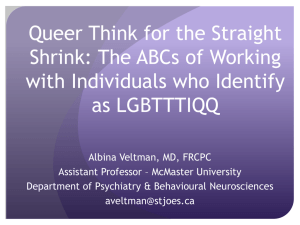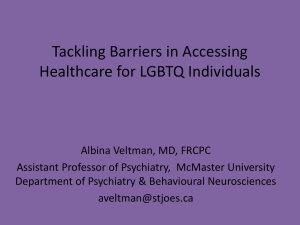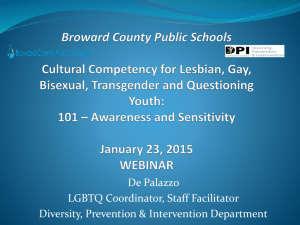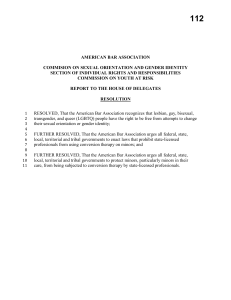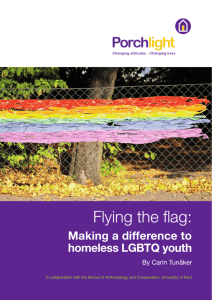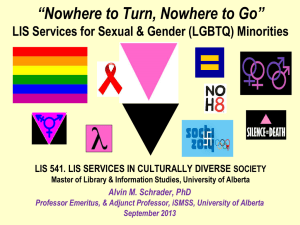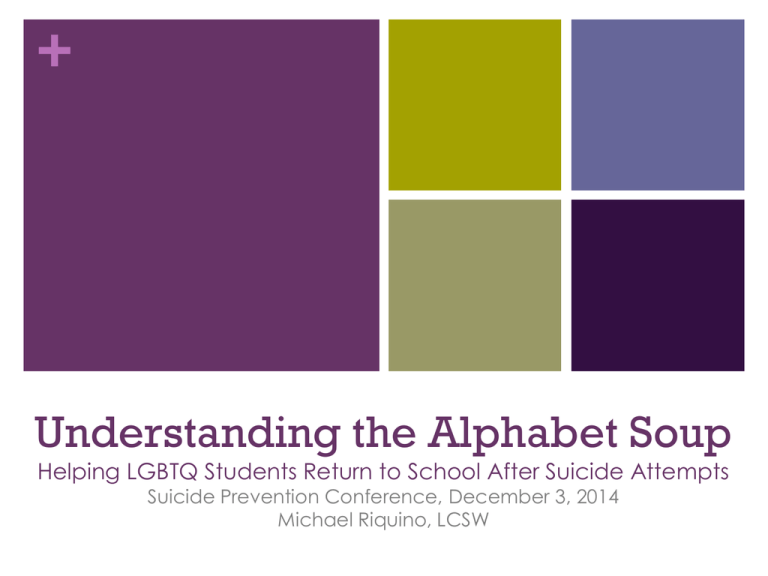
+
Understanding the Alphabet Soup
Helping LGBTQ Students Return to School After Suicide Attempts
Suicide Prevention Conference, December 3, 2014
Michael Riquino, LCSW
+
This presentation is rated PG-13
For potential hilarity and inevitable irreverence
including gay-themed jokes, political incorrectness,
and the ability to not take itself too seriously.
+
Helping LGBTQ Students
Return to School After Suicide Attempts
Learning Objectives
Step 1: Speak Their Language
Step 2: Recognize the Impact of Rejection
Step 3: Create Safe Spaces
A Few Items of Business
I talk really fast – no, I am not nervous
Feel free to ask questions as they come to you – but write them
down in case I’m unintentionally overlooking you
No, I will not be reading every slide word for word – that’s cruel
You will most likely be offended during this presentation – but
hopefully you think I’m funny
+
Why Alphabet Soup?
A Brief Queer Overview Including Sexual
Orientation and Gender Identity
Development in Just 14 Slides
Because the full acronym,
LGBTQQ2-SIAAP, is a
+ proverbial and growing
alphabet soup
Lesbian, Gay, Bisexual, Transgender,
Queer, Questioning, Two-Spirit, Intersex,
Ally, Asexual, and Pansexual
+
Lesbian
A woman who has a
continuing psychological,
emotional, physical, and/or
sexual attraction for other
women.
Ellen Degeneres
Portia de Rossi
Jane Lynch
Rosie O’Donnell
Cynthia Nixon
Melissa Etheridge
Brandi Carlile
Rachel Maddow
Wanda Sykes
Jodie Foster
Xena Warrior Princess
+
Gay
A man who has a
continuing psychological,
emotional, physical, and/or
sexual attraction for other
men. Although “gay” may
be used to include both
men and women, it is most
often used to refer to men.
Neil Patrick Harris
Ian McKellan
Matthew Bomer
Chris Colfer
Lance Bass
Adam Lambert
Anderson Cooper
Stephen Fry
Elton John
Jim Parsons
Albus Dumbledore
+
Bisexual
Someone who has a
continuing psychological,
emotional, physical, and/or
sexual attraction to persons
of the same and different
genders.
Angelina Jolie
Billie Joe Armstrong
Sia Furler
James Dean
Lady Gaga
Freddy Mercury
Anna Paquin
Margaret Cho
Drew Barrymore
Vanessa Carlton
Buffy the Vampire Slayer
+
Straight Ally
A heterosexual person who
supports equal civil rights,
gender equality, LGBT
social movements, and
challenges homophobia
and heterosexism.
Daniel Radcliffe
Barbra Streisand
Bette Midler
Anne Hathaway
Madonna
Cher
Darren Criss
Charlize Theron
Miley Cyrus
P!nk
Josh Hutcherson
+
Asexual
A sexual orientation
characterized by a lack of
sexual attraction. Unlike
celibacy, which is a
choice, asexuality is a
sexual orientation.
+
Pansexual
A sexual orientation
characterized by the
potential for aesthetic
attraction, romantic love,
and/or sexual desire for
people regardless of their
gender identity or
biological sex.
+
Questioning
Implies an individual is
questioning his or her sexual
and/or gender identity. It is
fairly common and a normal
part of human sexuality to
experience attraction to,
engage in sexual intimacy
with, or fantasize about
individuals of the same or
different genders regardless of
sexual orientation.
+
Sexual Identity and Gender
Identity Development
From the Substance Abuse and Mental Health Services
Administration (SAMHSA)
“Adolescents in our research for the Family Acceptance
Project (FAP) said they were attracted to another person of
the same gender at about age 10. Overall, they identified as
lesbian, gay, or bisexual, on average, at age 13. Their families
learned about their LGB identity about a year later.”
“Research on supporting both children’s gender identity and
transgender adolescents is very limited. Children develop
gender identity—a deep sense of being male or female—at
early ages. They express clear gender choices for clothes,
toys, and personal items. And they begin to express gender
identity at about ages 2-3.”
+
Queer
A controversial term literally
meaning unusual, but used for
people whose sexual and/or
gender identity differ from the
norm. Queer is also a unifying
umbrella term for people who
are lesbian, gay, bisexual,
transgender, and questioning.
In this usage, it is usually a
synonym for such acronyms as
LGBTQ.
+
Two-Spirit
An umbrella term for
individuals who fulfill one of
many mixed gender roles in
First Nations and Native
American Tribes. It can
also be used as a synonym
for such acronyms as
LGBTQ.
+
Transgender
An umbrella term for
individuals whose gender
identity and/or expression
does not conform to the
characteristics traditionally
associated with their
biological sex.
+
Cisgender
Refers to individuals whose
gender identity and/or
expression aligns with the
biological sex they were
assigned at birth.
+
Intersex
A person whose biological
sex is ambiguous. There
are many genetic,
hormonal, or anatomical
variations that make a
person's sex ambiguous.
[Intersex individuals were
formerly called
hermaphrodites.]
+
What’s the take home message?
There are way too many words to describe the seemingly endless
permutations of sexual orientation and gender identity, all wizards are
probably gay, and you had no idea Megan Fox identifies as bisexual.
+
The Impact of Rejection
How Family Rejection, School Bullying,
Homophobia, & Heterosexism Affect the
Mental Health of LGBTQ Students
+
Mental Health Facts and Figures
Mustanski, B.S., Garofalo, R., & Emerson, E.M. (2010). Mental health disorders,
psychological distress, and suicidality in a diverse sample of lesbian, gay, bisexual,
and transgender youths. American Journal of Public Health, 100, 2426-2432.
33% met criteria for at least one mental disorder
15% met criteria for major depression
31% will attempt suicide during their lifetime
LGBTQ youth are 2 to 7 times more likely to attempt suicide than
straight youth – attempts may be more serious due to intent & means
LGBTQ youth may represent up to 30% of completed suicides
From the Substance Abuse and Mental Health Services Administration (SAMHSA)
and the Suicide Prevention Resource Center (SPRC)
Compared with LGBT young people who were not
rejected or were only a little rejected by their parents and
caregivers because of their gay or transgender identity,
highly rejected LGBT young people were:
More than 8 times as likely to have attempted suicide
Nearly 6 times as likely to report high levels of depression
+
Risk Factors & Protective Factors
From the Substance Abuse and Mental Health Services Administration (SAMHSA)
and the Suicide Prevention Resource Center (SPRC)
Potential risk factors:
Gender nonconformity
Internal conflict about sexual
orientation/gender identity
Early coming out
Low family connectedness
Lack of adult caring
Unsafe school
Family rejection
Potential protective factors:
Family connectedness (feeling
cared about, understood,
and having fun and privacy)
Family acceptance (related
specifically to identity)
Safe schools
Caring adult (adults in
community, faith leaders, and
other adult relatives)
Victimization/bullying
High self-esteem
Stigma and discrimination
Positive role models
+
Identifying Potential
Sources of Rejection
Internalized homophobia
Personal acceptance and endorsement of sexual stigma as part of an
individual's value system and self-concept
Immediate and extended family
Friends, peers, and school personnel
Religion and community
Although religion is typically a protective factor against suicide, it
represents a risk factor for LGBTQ youth because of its association with
internal conflict, family rejection, and stigma and discrimination
Societal stigma and institutionalized discrimination
Hilton, S.C., Fellingham, G.W., & Lyon, J.L. (2002). Suicide rates and religious commitment
in young adult males in Utah. American Journal of Epidemiology, 155 (5), 413-419.
+
Family Behaviors that Increase Risk
for Health/Mental Health Behaviors
From the Substance Abuse and Mental Health Services Administration (SAMHSA)
Hitting, slapping, or physically hurting your child, verbal
harassment or name-calling because of their LGBT identity
Blocking access to LGBT friends, events, and resources
Blaming your child when they are discriminated against
because of their LGBT identity
Pressuring your child to be more or less masculine or feminine
Telling your child that God will punish them because they are
gay
Telling your child that you are ashamed of them or that how they
look or act will shame the family
Making your child keep their LGBT identity a secret in the family
and not letting them talk about their identity with others
+
Family Behaviors that Decrease Risk
for Health/Mental Health Behaviors
From the Substance Abuse and Mental Health Services Administration (SAMHSA)
Talk with your child about their LGBT identity
Express affection when your child tells you or when you learn
that your child is LGBT
Support your child’s LGBT identity even though you may feel
uncomfortable
Advocate for your child when he or she is mistreated because
of their LGBT identity
Require that other family members respect your LGBT child
Connect your child with an LGBT adult role model to show them
options for the future
Welcome your child’s LGBT friends and partner to your home
and to family events and activities
Believe your child can have a happy future as an LGBT adult
+
What’s the take home message?
The high rates of mental health concerns among LGBTQ youth should
be considered in the context of high rates of family rejection, bullying
and harassment, homophobia and heterosexism, religious intolerance,
and societal and institutional discrimination.
+
Creating Safe Spaces
Helping LGBTQ Students Return
to School After Suicide Attempts
+
What You Can Do to Help:
Getting Started
You are NOT required to:
March in a Pride parade (or even attend)
Advocate for marriage equality (or even believe it’s appropriate)
Believe homosexual behavior is acceptable
But you MUST:
Recognize everyone deserves kindness and respect - regardless
of sexual orientation or gender identity
Set aside your own personal beliefs - and recognize your own
biases/misconceptions
Remember acceptance is not the same as agreement or
approval
+
What You Can Do to Help:
Helping LGBTQ Youth at School
Identify supportive school personnel
Disclosures of sexual orientation/gender identity should be kept confidential
Address homophobic language/harassment (e.g., “That’s so gay”)
Adopt a comprehensive anti-bullying policy that includes sexual
orientation and gender expression/identity
Remember, language is important!
Start a Gay-Straight Alliance and support inclusive curricula
National Day of Silence, No Name-Calling Week, Spirit Day
Professional development and cultural competency trainings
Provide identity-affirming resources – all facets of identity!
+
Making the Case for
Gay-Straight Alliances
GSA’s are student clubs that work to improve school
climate for all students, regardless of sexual orientation or
gender identity/expression
From the Gay, Lesbian and Straight Education Network,
“Gay-Straight Alliances: Creating Safer Schools”
Students in schools with GSA’s are less likely to hear
homophobic remarks in school on a daily basis (57% vs. 75%)
Students in schools with a GSA are more likely to report school
faculty, staff, and administrators are supportive
of LGBTQ students (52% versus 37%)
LGBT students in schools with a GSA are more likely to be
aware of a supportive adult at school (84% versus 56%)
+
Providing Resources
GLSEN: Gay, Lesbian and Straight Education Network
National Education Organization for Safe Schools
The leading national
education organization
focused on ensuring safe
schools for all students
Research and resources
for educators, students,
and parents regarding
the educational needs of
LGBTQ youth
+
Providing Resources
The Trevor Project: 1-866-488-7386
National Suicide Prevention and Awareness Organization
The leading national
organization providing
crisis intervention and
suicide prevention
services to LGBTQ young
people ages 13-24
Resources for students,
administrators, teachers,
counselors, and school
social workers
+
Providing Resources
USGA: Understanding Same-Gender Attraction
An Unofficial Organization of Brigham Young University
Community resource for
graduating high school
students and adolescents
transitioning into young
adulthood
Weekly meetings are held
on Thursdays at 7:00 PM at
the Provo Library
+
Providing Resources
Parenting SIB Group
Wasatch Mental Health Provo Family Clinic
Open to the entire
community (Medicaid
and non-Medicaid)
3-week psychoeducation
group focused on
understanding self-injury
and how parents can
help their children stop
engaging in self-injury
+
The Trevor Project
GLSEN – Gay, Lesbian and Straight Education Network
PFLAG – Parents, Families & Friends of Lesbians and Gays
GLAAD – Gay & Lesbian Alliance Against Defamation
HRC – Human Rights Campaign
USGA at BYU – Understanding Same-Gender Attraction
Affirmation – LGBT Mormons, Family & Friends
Mormons Building Bridges
MormonsAndGays.org
Online Resources
+
What’s the take home message?
Gaydar is only effective 60% of the time. Seriously.
Someone actually spent time researching it.
+
It’s hard to hate someone whose story you know
“All of these lines across my face / tell you the story of who I am /
So many stories of where I’ve been / and how I got to where I am /
But these stories don’t mean anything / when you’ve got no one to tell
them to.” From The Story by Brandi Carlile.

